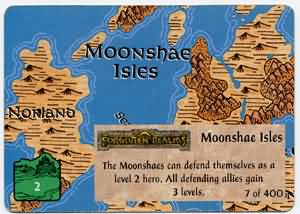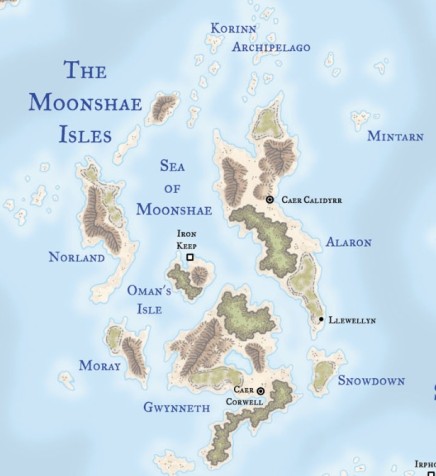

AT A GLANCE: The Moonshae Islands are
a large collection of islands well to
the west of the Sword Coast, and ruled
by a collection of more than a dozen
small kingdoms. Those kingdoms in the
southern parts of the island are held by
the Ffolk; farmers and fishermen who
were the original human inhabitants of
the islands. The kingdoms of the northern
regions of the Moonshaes are held
by the descendents of Northmen raiders.
The Moonshaes are blanketed with
many forests of oak, hickory, birch,
yew, and pines. Much of the land is
mountainous and rocky, or low, flat
bog. The coastlines are primarily rocky,
and brutal winter storms sweep the
islands during the winter months.
ELMINSTER'S NOTES: The Northmen
invaders of the Moonshae Islands are
decendents of the same stock as the
men of Luskan and Ruathym, further
north. Their depredations of the land
are gradually taking more and more
lands away from the more peaceful
Ffolk. Often, the raids will simply consist
of attacks to capture livestock or
slaves, though occasionally, the raiders
will land on a fertile coast and claim it as
their own.
The kingdoms of the Northmen are
run by warlords--strong and brutal
men who have won their posts through
a combination of might and cunning.
The kingdoms will generate food
through agriculture and farming only
to a subsistence level for that particular
kingdom. The Northmen feel that it is
far more honorable to pillage and plunder
for a living than to till the soil or fish
the sea.
No single king of the Northmen rules
the others, though the larger an army
or fleet that a king can muster, the more
influence he holds int he Northmen
councils. Thelgaar Ironhand, Grunnarch
the Red, and Raag Hammerstaad
are among the more powerful current
kings of the Northmen.
The lands of the Ffolk are also broken
into many small kingdoms. Unlike the
Northmen, however, all of the kings of
the Ffolk owe fealty to the High King,
who resides in his massive fortress at
Caer Callidyrr, on the island of Allaron.
The Ffolk concentrate much more
heavily than the Northmen on peaceful
pursuits, such as farming, fishing, hunting,
and trading. The lands they hold
tend to be more hospitable than the
domains of the Northmen, and consequently
provide a wealth of agricultural
produce, but also serve as an everpresent
invitation to the raiders' greed.
The sturdy trading vessels of the
Ffolk travel throughout the Moonshaes
and along the Sword Coast, and are
famous for their capacity to weather
the roughest seas. They are slow,
unmanueverable boats, however, and
thus fall easily when attacked by the
longships of the Northmen.
The largest of the Moonshae Islands,
Gwynneth, contains a small region still
inhabited by the island' original residents.
This region is a broad valley,
with a huge and cold lake in the center
called Myrloch. The entire region is
referred to as Myrloch Vale, and
rumors among both the Northmen and
the Ffolk speak of the enchanted nature
of the place. Here dwell small bands of
reclusive dwarves and firbolg giants.
Myrloch Vale is a place of enchantment
and beauty. Certain creatures,
especially favored by the Earthmother,
live there. These include a unicorn,
faerie dragons, and a pack
of wolfdogs,
said to slumber for decades, only awakening
when the goddess calls them for
some important task.
Also rumored to live somewhere
within Myrloch Vale is a small group of
demi-humans known as the Llewyrr: an
elvish people whose population has
shrunk dramatically with the coming of
the humans to the Moonshaes. The Llewyrr
have the physical appearance of
slender gold elves, but their ways are
attitudes are more in line with the wild
elves.
All of the dominant native races of the
Moonshaes, including the Ffolk and
excluding the Northmen, worship a
goddess that is visualized as the mother
of all life, and indeed of the earth itself.
She is often referred to as the
"Earthmother." The words of the goddess
are spread through her druids,
humans who dwell among her wildest
and most sacred places, dealing more
directly with the earth itself than the
humans who live upon it. These druids
tend to consider themselves a breed
apart from those on the mainland of
Faerun, and are polite, though distant
and reserved, in dealing with such druidic
circles.
The Northmen worship a stormy
aspect of Tempus, god of war, through
their own shamans. These shamans
encourage Tempus' teachings which
support their conception of the world
as a victim waiting for the raiders' plundering
boots.
Over the past hundred winters, clerics
teaching the faiths of some of the
other religions of the Realms have
arrived in the kingdoms of the Moonshaes,
and have attempted to spread
their own faiths. These clerics have
generally met with death among the
Northmen, and an amused disbelief
among the Ffolk. In the later case, the
clerics of the new gods have made a few
converts, but the Ffolk by and large
remain true to their ancient beliefs.
The central conflict in the Moonshae
Islands is the struggle between the raiders
and the Ffolk. Although these two
peoples interact through commerce,
trouble is never far away when both
groups are in the same place. Within
the Ffolk's society, conflicts about the
new faiths versus the old religion are
common. Also, tactics for dealing with
the Northmen are frequently debated,
and alliances among the various kingdoms
of Ffolk can be made and broken.
GAME INFORMATION: More information
on the Moonshae Islands is available in the novel Darkwalker on
Moonshae, by Douglas Niles,
and the Forgotten Realms Sourcebook FR-2,
MOONSHAE.

![]()
Reduce - Reuse - Recycle